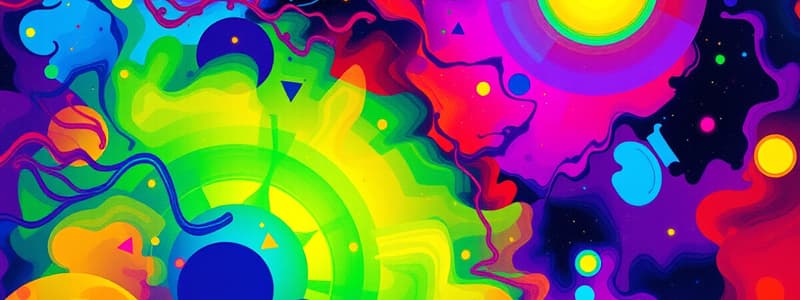Podcast
Questions and Answers
What is spectroscopy?
What is spectroscopy?
- A study of the geometry of rainbows
- The use of CCDs to capture light more efficiently than with photographic film
- A method to freeze atmospheric turbulence for better resolution
- An observational technique to measure the brightness of light at different colors
- An analysis of the way in which atoms absorb and emit light (correct)
In the atom, which particles give the element its identity (atomic number)?
In the atom, which particles give the element its identity (atomic number)?
- Protons (correct)
- Electrons
- Neutrinos
- Positrons
- Neutrons
The particles which enter into chemical reactions are the atom's:
The particles which enter into chemical reactions are the atom's:
- Electrons (correct)
- Positrons
- Mesons
- Protons
- Neutrons
A hydrogen atom consists of an electron and a(n):
A hydrogen atom consists of an electron and a(n):
The particle which adds mass but no charge to the atomic nucleus is the:
The particle which adds mass but no charge to the atomic nucleus is the:
An emission spectrum can be used to identify a(n):
An emission spectrum can be used to identify a(n):
In Bohr's model of the atom, electrons:
In Bohr's model of the atom, electrons:
In space, positive ions are the result of:
In space, positive ions are the result of:
Typical stellar spectra appear as:
Typical stellar spectra appear as:
To have a negative ion, you must have:
To have a negative ion, you must have:
For hydrogen, the transition from the second to the fourth energy level produces:
For hydrogen, the transition from the second to the fourth energy level produces:
A heavy neutral atom, such as iron, produces many spectral lines compared to light elements like hydrogen and helium. Why?
A heavy neutral atom, such as iron, produces many spectral lines compared to light elements like hydrogen and helium. Why?
Which of these is the classic continuous spectrum?
Which of these is the classic continuous spectrum?
Why are molecular lines more complex than elemental spectral lines?
Why are molecular lines more complex than elemental spectral lines?
The splitting of spectral lines in the presence of strong magnetic fields is the:
The splitting of spectral lines in the presence of strong magnetic fields is the:
Spectral lines are often referred to as the stars' 'fingerprints' because:
Spectral lines are often referred to as the stars' 'fingerprints' because:
The broadening of spectral lines can be caused by:
The broadening of spectral lines can be caused by:
According to the Zeeman effect, the splitting of a sunspot's spectral lines is due to:
According to the Zeeman effect, the splitting of a sunspot's spectral lines is due to:
What information about an astronomical object can be determined by observing its spectrum?
What information about an astronomical object can be determined by observing its spectrum?
The Orion Nebula, M-42, is a hot, thin cloud of glowing gas, so its spectrum is:
The Orion Nebula, M-42, is a hot, thin cloud of glowing gas, so its spectrum is:
An incandescent light (glowing tungsten filament) produces:
An incandescent light (glowing tungsten filament) produces:
A neon light (thin hot neon gas in a sealed tube) gives us:
A neon light (thin hot neon gas in a sealed tube) gives us:
Flashcards are hidden until you start studying
Study Notes
Spectroscopy and Atomic Structure
- Spectroscopy involves analyzing how atoms absorb and emit light, providing insight into elemental identity.
- Protons define an element's atomic number, distinguishing one element from another.
- Electrons are the particles that participate in chemical reactions, influencing chemical behavior and bonding.
Hydrogen Atom Composition
- A hydrogen atom comprises one electron and one proton, fundamental for understanding molecular formation.
Neutrons and Atomic Mass
- Neutrons contribute mass to the atomic nucleus without adding electrical charge, essential in isotopic variation.
Emission and Absorption
- An emission spectrum can identify specific atoms, reacting predictably to varying energy states.
- In Bohr's atomic model, electrons transition strictly between defined energy levels, dictating their radiative properties.
Ionization and Stellar Spectra
- Positive ions in space result from electrons being stripped from outer shells of hot atoms during energetic processes.
- Stellar spectra typically display as a rainbow interspersed with dark lines (absorption lines), characteristic of elements present.
Ion Formation and Spectral Lines
- Negative ions form when an additional electron is added to an atom's outer shell, affecting the atom's charge balance.
- The transition in hydrogen from the second to the fourth energy level produces a blue-green absorption line, revealing electron behavior.
Complex Spectral Emissions
- Heavier atoms, like iron, generate complex spectra due to a larger number of electrons and energy transitions available.
- Molecular spectral lines are more intricate than those of elemental atoms due to additional vibrational and rotational states.
Zeeman Effect and Spectral Broadening
- The Zeeman effect describes the splitting of spectral lines in strong magnetic fields, providing insights into magnetic properties.
- Spectral line broadening can result from various factors including magnetic fields, atom density, thermal motion, and stellar rotation.
Information from Spectra
- Spectra enable the determination of an astronomical object's magnetic field strength, chemical composition, radial motion, and temperature, crucial for astrophysical analysis.
Nebulae and Light Sources
- The Orion Nebula's spectrum presents bright lines on a dark background, indicating its hot, glowing gas composition.
- Incandescent light sources produce a continuous spectrum with a temperature peak indicating thermal properties.
- Neon lights emit distinct bright lines, signaling the presence of neon gas through their unique spectral emissions.
Studying That Suits You
Use AI to generate personalized quizzes and flashcards to suit your learning preferences.




